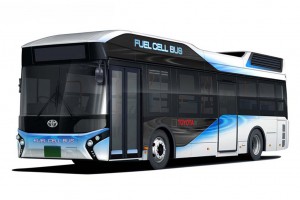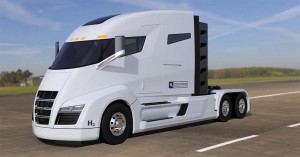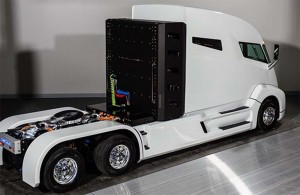A Utah-based start-up hoping to transform the heavy-duty truck industry has rolled out its first hydrogen-powered prototype.
Dubbed Nikola One, the big rig replaces the conventional diesel truck engine with a fuel-cell stack capable, it claims, of delivering the equivalent of 20 miles per gallon – or twice what the best of today’s heavy trucks can deliver. And officials from Nikola Motor Co. claim the rig will get up to 1,200 miles on a tank – though the big challenge today would be finding places to fill up.
“There are many out there that wondered if we would deliver, but today we proudly show off the most advanced semi-truck ever built,” declared Nikola founder and CEO Trevor Milton, during a well-attended debut in Salt Lake City.
The project has drawn praise from a variety of quarters, especially in the environmental community. Trucks are considered some of the biggest polluters on the road. Despite efforts by the EPA to clean them up, diesel rigs produce a disproportionate share of particulates and smog-causing oxides of nitrogen, as well as an estimated 20% of the global warming gases from the transportation sector.
(Outgoing Obama EPA upholds 54.5 mpg mileage rules. Click Here for the full story.)
While scaled up significantly, the underlying technology behind Nikola One is the same as that found in the new Honda Clarity Fuel-Cell Vehicle. Compressed hydrogen is pumped through a device called a stack where it is combined with oxygen from the air. That creates a stream of current used to run electric motors, just like a battery-electric vehicle.
But fuel-cell vehicles have significantly better range and refueling is quick. For the Honda Clarity, it takes just five minutes, about the same time as refilling a conventional gas tank. The process would be similar for a truck like Nikola One.
The Utah start-up’s prototype uses a 6×6 layout making 1,000 horsepower and 2,000 pound-feet of torque, in-line with today’s diesel trucks. Nikola estimates its fuel economy at an equivalent of 15 to 20 mpg, with range of up to 1,200 miles.
The initial 5,000 models will be produced by Fitzgerald Glider Kits, of Byrdstown, Tennessee. But the company is now working with several unspecified states to pick the site for a $1 billion assembly plant. The goal is to announce details by the middle of next year and have production begin sometime in 2020.
Nikola initially plans to offer the Nikola One, and a slightly less expensive version dubbed Nikola Two, in North America. It claims to already have $3 billion in orders in hand.

Toyota plans to introduce over 100 FC buses mainly in the Tokyo area, ahead of the Tokyo 2020 Olympics.
To increase the appeal, the company is taking a crucial step to overcome the single biggest drawback of hydrogen power: the lack of a nationwide production and distribution infrastructure. Nikola plans to set up a network of 364 of its own hydrogen fueling stations in the U.S. and Canada.
The distribution shortfall is one of the reasons that automakers like Toyota have been slow to roll out hydrogen-powered passenger vehicles. Toyota, for example, will only sell its new Mirai fuel-cell vehicle in select parts of California where about 20 fueling stations are located. Honda and Hyundai put similar restrictions on their own hydrogen cars.
But some proponents believe that by focusing on the medium and heavy-duty truck sectors there could be new momentum for fuel-cell power. That’s one reason Toyota last month announced it would also develop truck applications for its hydrogen technology.
(What! You didn’t celebrate Hydrogen Day? Click Here to see what you missed.)
“Toyota has long maintained that hydrogen fuel cell technology could be a zero emission solution across a broad spectrum of vehicle types,” the Japanese maker said in a brief statement announcing its own program. “The scalability of this technology is enabling the automaker to explore a semi-trailer truck application for a California-based feasibility study.”
Toyota is already scaling up the fuel-cell system found in the Mirai. The world’s largest automaker just last month said it will begin selling hydrogen buses and will work with the Tokyo Metropolitan Government to get a fleet of as many as 100 of those vehicles into service ahead of the 2020 Olympics which will be held in the Japanese capital.
(Click Here for more on Toyota’s own hydrogen truck program.)



Please send me information as it is received and any updates thank you